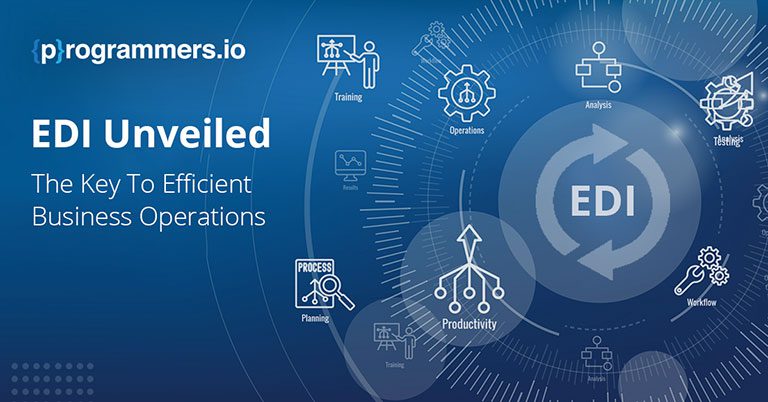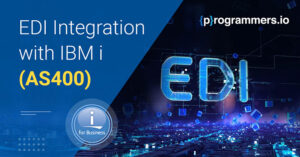EDI Unveiled The Key To Efficient Business Operations
“Do you want to revolutionize your data exchange techniques because you are tired of the limitations of outdated methods?”
Get rid of bottlenecks in data exchange with EDI.
What is EDI?
Electronic Data Interchange (EDI) is the electronic exchange of business documents between computers. It facilitates structured data exchange between trading partners, such as purchase orders, invoices, and shipping notices. EDI eliminates manual data entry and reduces human error by replacing paper-based communication.
It simplifies the transfer of documents, such as purchase orders, invoices, and shipping notices, ensuring accurate and efficient data exchange. There is a bidirectional exchange of documents between them, i.e., Inbound and Outbound.
How Does EDI Work?
The EDI protocol relies on a standard messaging format, typically ANSI X12 or UN/EDIFACT. To ensure consistency and compatibility across multiple systems, data is segmented, organized into elements, and categorized into data elements. EDI documents are transmitted through secure communication protocols such as AS2, FTP, or VANs (Value Added Networks) to protect data integrity and confidentiality.
How To Understand EDI?
To fully comprehend EDI, it is crucial to acquaint oneself with the essential vocabulary in this area. Below are some standard terms you may encounter:
- Elements: the building blocks of Segments.
- Segments: a set of interrelated Elements.
- Transaction Set: a group of Segments arranged in a specific order and translated into meaningful information.
When compared with languages such as English, EDI is understandable as Elements can be taken as Words, Segments as Sentences, Transaction Sets as Paragraphs, and Rules as Grammar.
EDI Standards
EDI standards define the format, structure, and syntax of electronic data interchange (EDI) documents. They allow seamless communication and data exchange between trading partners by ensuring uniformity, consistency, and compatibility.
Here is a list of the applicable standards in EDI:
1. ANSI X12 (American National Standard Institution)
2. UN/EDIFACT (the United Nations Rules for Electronic Data Interchange for Administration, Commerce, and Transport)
3. SPEC 2000/iATA (International Airline Transport Association)
4. WINS format for the warehouse industry
5. UCS format for the food and drug industry
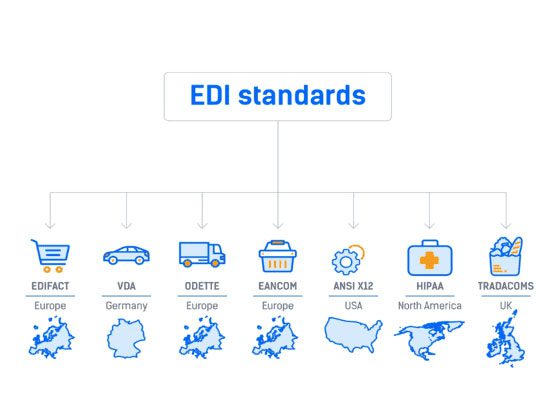
There are several EDI standards available, but the most often used ones are ANSI X12 used in the US & Canada and UN/EDIFACT used primarily in Europe.
ANSI X12 and its Components
ANSI X12 specifies the structure, format, and syntax of EDI documents. The design allows business data such as purchase orders, invoices, shipping notices, and payment remittances to be represented and transmitted in a standardized format.
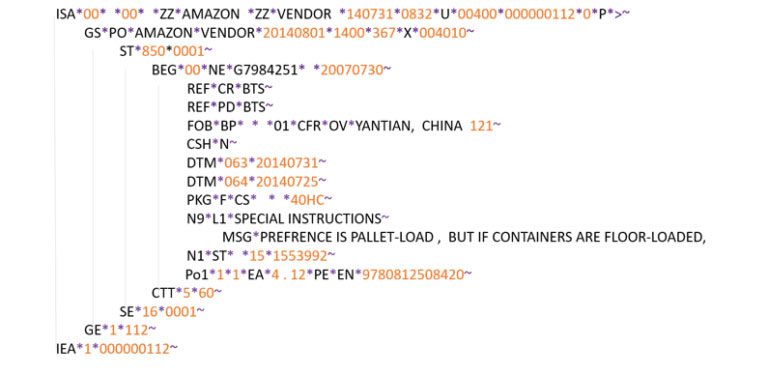
The critical components of ANSI X12 include the following:
- Element: the building blocks of EDI documents.
- Segments: a group of Elements arranged and separated by an Element Separator.
- EDI Documents: A series of Segments arranged in a specific order form or EDI document.
- Element Separator: Each Element in the Segment is separated by a distinctive character. This distinctive character is called an Element Separator.
- Segment Terminator: A character who appears at the end of a segment or between segments is called a Segment Terminator.
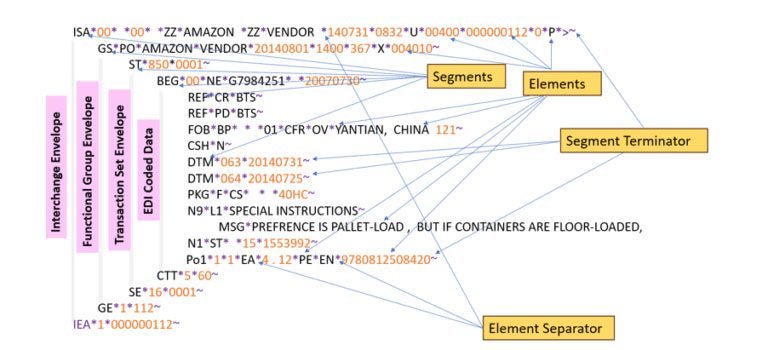
Interchange Envelope
In an EDI document, the first segment is an ISA segment, and the last is an IEA segment. Information related to EDI documents is enclosed between the ISA and IEA segments. A block of ISA and IEA segments is called an Interchange Envelope.
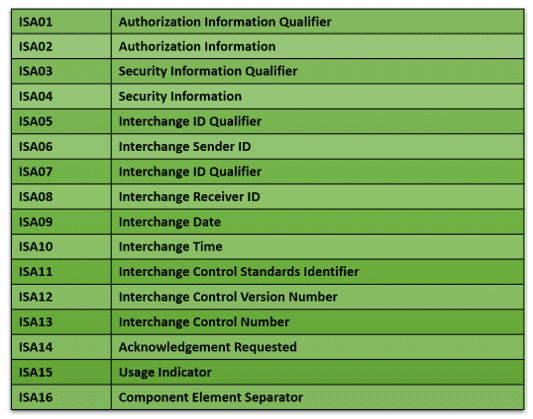
Interchange envelopes contain information such as sender and recipient names, EDI standards, or sequence numbers. The EDI document is passed from the source to the destination address in this segment. The length of this envelope is fixed at 106 for version 04010 and 108 for version 05010.
Functional Group Envelope
In an EDI document, the second segment is the GS segment, and the second last segment is the GE segment. The Functional Group Envelope is the block containing the GS and GE segments. It helps ensure the integrity and proper handling of the enclosed transactions.
It provides a logical grouping mechanism to organize and manage multiple transactions exchanged between trading partners.
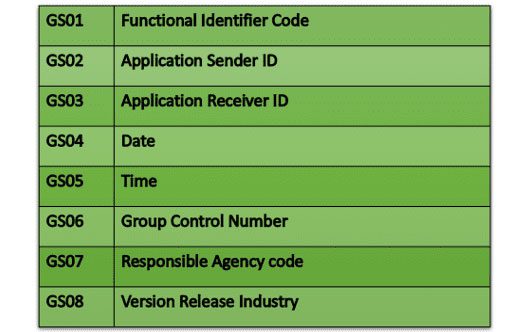
Transaction Set Envelope
In an EDI document, the third segment is the ST segment, and the third last segment is the SE segment. A Transaction Set Envelope is a block of ST and SE segments. A Transaction Set Envelope contains information about the EDI Document Number and the Transaction Set Control Number.
For example, 850 for Purchase Order, 856 for ASN, 810 for Invoice, etc..

Benefits of EDI
- Increased Efficiency: EDI eliminates manual processes, reducing the time and effort required for data entry, document processing, and reconciliation. Streamlining transactions leads to faster transactions, improved productivity, and lower costs.
- Error Reduction: Manual data entry is prone to errors, such as missing information, or misinterpretation. By automating data exchange, EDI reduces errors and improves data accuracy.
- Enhanced Visibility: EDI provides visibility into transaction status, inventory levels, and order fulfillment. Proactive decision-making is enabled by this visibility.
- Cost Savings: By eliminating paper-based processes, EDI reduces printing, mailing, and storage costs. In addition, EDI reduces labor costs related to manual document processing and data entry through automation and efficiency.
Disadvantages of EDI
- Upfront Costs: Setting up an EDI infrastructure often involves initial investment in hardware, software, and implementation services. Business owners and entrepreneurs with limited financial resources may find these upfront costs prohibitive.
- Dependency on Trading Partner Compliance: Successful EDI implementation relies on the cooperation and compliance of trading partners. A trading partner that is not capable of receiving or sending EDI documents may disrupt the seamless flow of information, requiring a fallback to traditional methods of communication, and increasing the risk of delays and manual intervention.
- Technical and Communication Challenges: EDI relies on consistent and reliable communication channels between trading partners. A technical issue, such as network failure or connectivity issues, can cause EDI transmissions to fail.
Conclusion
In the 21st century, the Electronic Data Interchange (EDI) has transformed the way businesses communicate. By using EDI, manual processes are eliminated and data can be exchanged more efficiently, leading to greater operational effectiveness and sustainable growth. Across various industries and company sizes, implementing EDI has become crucial for businesses to succeed in the digital age. It enhances productivity, boosts customer satisfaction, and eliminates errors in data entry, resulting in more accurate information exchange.
EDI eliminates paper-based processes, resulting in significant savings and strategic resource allocation. For businesses to maintain a competitive edge, they must welcome the latest EDI features, embrace enhanced functionalities, and optimize their implementations. Organizations can dramatically improve efficiency, mitigate risks, and position themselves for success in a digital economy by incorporating EDI into their communication strategies.
How can we help you?
We have hundreds of highly-qualified, experienced experts working in 70+ technologies.
